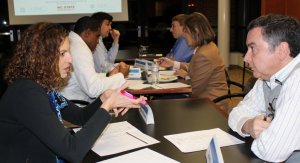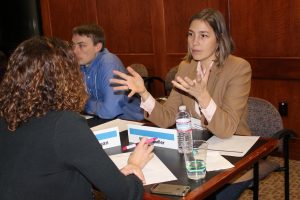

The center hosted its second speed-date at the Pagano Conference Room to match biomedical engineers from the UNC & NC State Joint Department of Biomedical Engineering with surgeons from the UNC School of Medicine Department of Surgery. They met in short, six minute sessions to propose innovative engineering solutions for problems they want to solve.
“The reason we’re doing this, and the reason why we’re bringing you all together, is we think surgery as a specialty has a lot of synergy with biomedical engineering,” said the event organizer Jen Jen Yeh, MD, a UNC Lineberger member and an associate professor and the vice chair for research at the UNC School of Medicine Department of Surgery and associate professor in the Department of Pharmacology. “I think the speed date is a way to leverage the huge amount of academic and clinical excellence and innovation across these two campuses to benefit patients.”
After the speed-date sessions, the participants formed collaborative teams to pitch ideas for research projects. Funding was provided by UNC Lineberger to support cancer treatment-related ideas and from the Department of Surgery and the Joint Department of Biomedical Engineering for other proposed medical solutions. The top three teams won funding. The top two teams can receive $15,000, and the third-place team can claim $8,000.
Surgeons came to the event with questions of how to use imaging to determine which pancreatic cancer patients would benefit from surgery to questions of how to improve upper limb prosthetics. Engineers presented expertise in areas ranging from micro-gel materials to knowledge of how different materials behave under stress and in extreme environments.
Three teams were chosen by popular vote to receive awards:
- Kandace McGuire, MD, a clinical associate professor in the UNC School of Medicine Division of Surgical Oncology and David Lalush, PhD, an associate professor in the UNC & NC State Joint Department of Biomedical Engineering, pitched a study that will use PET/MRI to examine the effect of neoadjuvant chemotherapy for women with breast cancer. They want to improve physicians’ ability to assess patient response to treatment and better plan surgery.
- Loree Kathlee Kalliainen, MD, a clinical associate professor in the UNC School of Medicine Division of Plastic and Reconstructive Surgery, and Helen Huang, PhD, associate professor biomedical engineering in the UNC & NC State Joint Department of Biomedical Engineering and director of the Rehabilitation Engineering Center, proposed a project to improve upper limb prosthetics to make them more intuitive, functional and responsive for patients with amputations. Trauma and soft tissue cancer patients are sometimes faced with the amputation of a limb.
- Mark Pankow, assistant professor in the N.C. State University Department of Mechanical & Aerospace Engineering and Larry Kim, MD, a professor in the UNC School of Medicine Department of Surgery Division of Surgical Oncology, won third place. They pitched a proposal for surgical scissors that would also be able to simultaneously cauterize tissue to prevent bleeding.
To claim their funding, the teams will need to get the necessary institutional approvals for their projects, and provide a description of their research with a timeline and milestones. Yeh plans to track the progress of the teams moving forward, including a face-to-face meeting in six months’ time.
